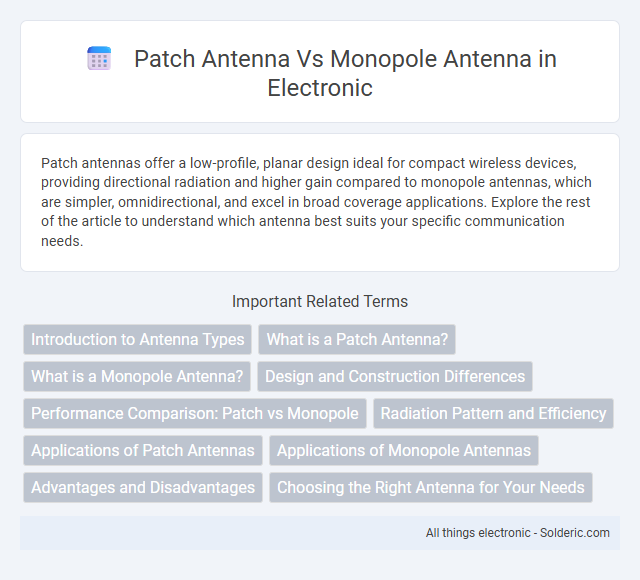Patch antennas offer a low-profile, planar design ideal for compact wireless devices, providing directional radiation and higher gain compared to monopole antennas, which are simpler, omnidirectional, and excel in broad coverage applications. Explore the rest of the article to understand which antenna best suits your specific communication needs.
Comparison Table
| Feature | Patch Antenna | Monopole Antenna |
|---|---|---|
| Design | Flat, rectangular or circular metallic patch on a ground plane | Vertical rod or wire above a ground plane |
| Size | Compact, low profile | Generally longer, taller than patch antenna |
| Radiation Pattern | Directional, broadside radiation | Omnidirectional in the horizontal plane |
| Polarization | Linear or circular polarization possible | Primarily linear polarization |
| Bandwidth | Narrow to moderate (typically a few percent of center frequency) | Wide bandwidth |
| Gain | Moderate gain (5-9 dBi typical) | Lower to moderate gain (2-6 dBi typical) |
| Applications | Wireless communications, GPS, Bluetooth, RFID | Mobile devices, base stations, wideband communications |
| Fabrication | PCB based, easy integration with circuits | Simple wire or rod, mechanical robustness |
| Efficiency | Moderate efficiency, affected by substrate losses | High efficiency with proper ground plane |
Introduction to Antenna Types
Patch antennas feature a flat, rectangular metallic surface mounted on a grounded substrate, ideal for compact, low-profile applications with moderate gain and directional radiation patterns. Monopole antennas consist of a single conductive element mounted over a ground plane, offering omnidirectional radiation characteristics and simple construction suited for wideband and mobile communications. Both antenna types play crucial roles in wireless systems, with patch antennas preferred in embedded devices and monopole antennas common in base stations and portable radios.
What is a Patch Antenna?
A patch antenna consists of a flat metallic patch mounted over a grounded substrate, designed to radiate electromagnetic waves primarily in one direction. It offers a compact, low-profile structure ideal for applications requiring directional communication and efficient space usage. Your system benefits from its ease of fabrication and integration in devices like GPS, WLAN, and satellite services.
What is a Monopole Antenna?
A monopole antenna is a type of radio antenna consisting of a single conductive element, typically a metal rod or wire, mounted perpendicular to a conductive ground plane. It operates as a quarter-wavelength radiator, using the ground plane as a reflective surface to form an effective dipole antenna. Monopole antennas are widely used in applications requiring omnidirectional radiation patterns and compact designs, such as mobile communications and broadcasting.
Design and Construction Differences
Patch antennas feature a flat, rectangular metal patch mounted on a grounded substrate, offering a low-profile, planar design ideal for compact devices. Monopole antennas consist of a single vertical conductor, typically a metal rod or wire, positioned over a ground plane, resulting in a simple and easily constructed omnidirectional radiator. Your choice depends on space constraints and radiation pattern requirements, as patch antennas enable directional control while monopoles provide broader coverage.
Performance Comparison: Patch vs Monopole
Patch antennas offer high directional gain and stable radiation patterns, making them ideal for applications requiring focused signal transmission, while monopole antennas provide omnidirectional coverage with simpler design and broader bandwidth. Your choice depends on performance needs: patch antennas excel in environments demanding low-profile, high-efficiency communication, whereas monopoles suit scenarios needing wide-area connectivity and ease of deployment. Consider factors like gain, size, bandwidth, and radiation pattern when comparing patch and monopole antennas for optimized wireless communication.
Radiation Pattern and Efficiency
Patch antennas exhibit a directional radiation pattern with a typically broadside main lobe, offering higher gain and reduced interference in targeted directions compared to monopole antennas, which produce an omnidirectional pattern radiating uniformly in the azimuthal plane. The efficiency of patch antennas is often lower due to surface wave losses and substrate dielectric losses, whereas monopole antennas generally achieve higher radiation efficiency since they radiate energy more uniformly and incur fewer dielectric losses. Understanding these differences can help optimize Your antenna design based on whether directional gain or broad coverage with higher efficiency is more critical.
Applications of Patch Antennas
Patch antennas are widely used in wireless communication systems, including Wi-Fi routers, GPS devices, and satellite communication, due to their compact size and ease of integration with printed circuit boards. They are favored in mobile devices and aerospace applications for their low profile and ability to conform to curved surfaces. The patch antenna's suitability for phased array systems and RFID tags further highlights its versatility in modern telecommunication infrastructure.
Applications of Monopole Antennas
Monopole antennas are widely used in mobile communication systems, including cell phones and wireless networks, due to their omnidirectional radiation pattern and compact size. They serve critical roles in vehicle-mounted radios, emergency services, and RFID systems, offering reliable performance in diverse environments. Their ease of fabrication and low profile make them ideal for applications requiring efficient signal transmission over broad frequency ranges.
Advantages and Disadvantages
Patch antennas offer compact size, low profile, and ease of fabrication, making them ideal for applications requiring integration into devices with limited space. However, they exhibit lower gain and narrower bandwidth compared to monopole antennas, which provide omnidirectional radiation patterns and wide bandwidth suitable for versatile communication needs. Your choice depends on balancing the trade-offs between the patch antenna's form factor and the monopole's superior overall performance in signal coverage.
Choosing the Right Antenna for Your Needs
Patch antennas offer a compact, low-profile design ideal for applications requiring directional radiation and high-frequency performance, while monopole antennas provide omnidirectional coverage with simpler fabrication and broader frequency range adaptability. Your choice depends on factors such as space constraints, desired radiation pattern, operating frequency, and gain requirements. Selecting the right antenna ensures optimal signal strength and efficiency tailored to your wireless communication needs.
patch antenna vs monopole antenna Infographic

 solderic.com
solderic.com